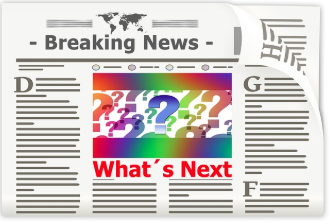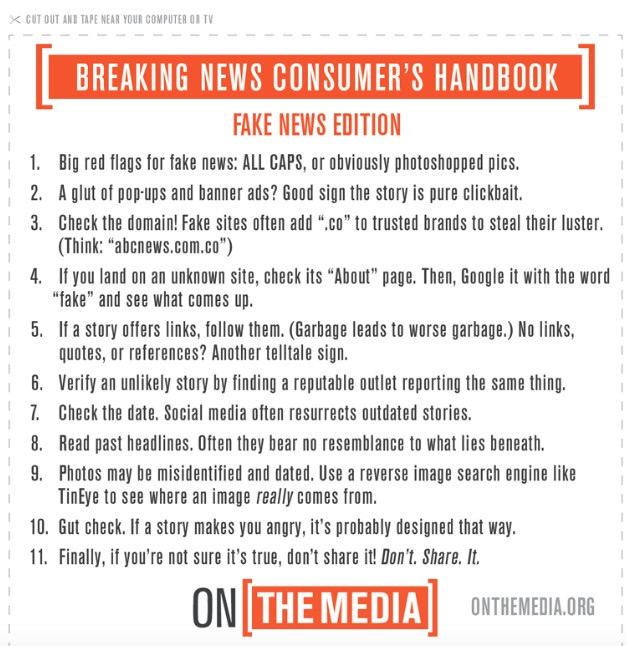Fake or Real

Several recent studies show that most children first get their news from families, friends and teachers. This means that children’s news experiences are filtered through adults, who bring their own knowledge, interpretations, and biases to the information they pass on. It is important then that teachers are receiving their news from verified sources and teaching students how to substantiate any news they find.
Even though they trust the news they hear from their parents and teachers, research is showing that they prefer to get it from social media. Students tend to take information at face value and so teaching them to be critical, thoughtful consumers of information is a challenge that's increasing.
Steps:
1. Begin by reading this article from NPR published in Dec 2016. Read how students admit they don't consume news from traditional sources: not from TV networks or newspapers or even the websites of the major papers. The teens interviewed say they get their news largely from social media on their smartphones.
- Here is a parent guide that just came out from the National Association of Media Literacy in Education. This guide gives parents real-life examples of conversations that may come up at home and provides parents with some simple ways to encourage critical thinking at home
2. Common sense media has conducted research for the past decade on the impact of social media on children and teens. Here are several interesting studies to read from the past couple of years.
- Media Use by Teens and Tweens
- Tweens, Teens, Tech, and Mental Health: Coming of Age in an Increasingly Digital, Uncertain, and Unequal World 2020
- Social Media, Social Life: Teens Reveal Their Experiences, 2018
3. Next read the article called Media Literacy: Five Ways Teachers Are Fighting Fake News. There are five great lesson ideas for you to use with students. One of the teachers cited, Scott Bedley, uses a seven-point checklist for his students when they are reading articles on the Internet.
-
Do you know who the source is, or was it created by a common or well-known source? (e.g.; National Geographic, Discovery, etc.)
-
How does it compare to what you already know?
-
Does the information make sense? Do you understand the information?
-
Can you verify that the information agrees with three or more other sources that are also reliable?
-
Have experts in the field been connected to it or authored the information?
-
How current is the information?
-
Does it have a copyright?
4. Fortunately, there are also fact-checkers that are available for you to validate stories you have heard or read. But, are the fact-checker sites trustworthy? There is an International Fact-Checking Network that uses a code of ethics and lists fact-checking sites across the globe so that you can compare between countries and see a profile about each site.
5. Find a story you have read recently or heard from a friend or student. Use one of the sites below as well as the 7 point checklist above to validate your story.
- Snopes.com is a popular fact-checker for rumors and stories you might hear or read on the Internet. (Be aware that Snopes may not always be accurate - the site does continuously fact check)
-
Sourcewatch is published by The Center for Media and Democracy (CMD) a nonprofit watchdog and advocacy organization and checks for media bias
-
There are also political fact checker sites.
-
FactCheck.org launched in 2003 is a project of the Annenberg Public Policy Center of the University of Pennsylvania. The site fact-checks claims made by the president, members of Congress, presidential candidates, and other members of the political arena.
-
Media Bias/Fact Check is a comprehensive media bias resource on the internet. There are currently 3300+ media sources listed in their database and growing every day. Don’t be fooled by Fake News sources. Use the search feature (Header) to check the bias of any source. Use a name or the URL.
-
Politifact is a project of the Tampa Bay Times. It won a Pulitzer Prize for its coverage of the 2008 election, during which it examined 750 claims. Politifact fact-checks claims by politicians at the federal, state, and local level, as well as political parties, PACs, and advocacy groups.
- Washington Post's Fact Checker blog is run by journalist Glenn Kessler. The site assesses claims made by politicians or political advocacy groups and gives out Pinocchios based on its level of accuracy.
-
6. On the Media from WYNC published a blog post called The Breaking News Consumer's Handbook. In the blog post, they published the handy graphic below to cut out and place next to your computer as you are doing research and trying to decipher what is real and fake. There are 11 handy tips to help you quickly determine what is real or fake. If you are not sure, make sure to fact check!

You now have some excellent resources to help you determine the difference between real and fake news. In the next section, you will learn about news bias.
Move on to Detecting Bias in the News.
Standards
Addressing the ISTE Standards For Educators
Learner
1a. Set professional learning goals to explore and apply pedagogical approaches made possible by technology and reflect on their effectiveness.
1c. Stay current with research that supports improved student learning outcomes, including findings from the learning sciences.
Leader
2b. Advocate for equitable access to educational technology, digital content and learning opportunities to meet the diverse needs of all students.
2c. Model for colleagues the identification, exploration,
evaluation, curation and adoption of
new digital resources and tools for learning.
Citizen
3a. Create experiences for learners to make positive, socially responsible contributions and exhibit empathetic behavior online that build relationships and community.
3b. Establish a learning culture that promotes curiosity and critical examination of online resources and fosters digital literacy and media fluency.
3c. Mentor students in safe, legal and ethical practices with digital tools and the protection of intellectual rights and property.
3d. Model and promote management of personal data and digital identity and protect student data privacy.
Additional Resources
Additional Resources
Articles
- Harvard Guides for Fake News
- NPR Ed - The Classroom Where Fake News Fails
- Battling Fake News in the Classroom
- Evaluating Information Applying the CRAAP Test
- Evaluating Sources: Hoaxes, Fakes, & Other Tricks
- Identifying Fake News An Infographic from EasyBib
Fact-Checker Websites
Videos
Lesson Plans
Fun & Interactive Games
Test your observational skills with one or more of the following:
- Spot a Troll: You decide if each is an authentic account or a professional troll. After each profile you will review the signs that can help you determine if it's a troll or not. https://spotthetroll.org/start
- FakeOut: Your social media feed has been infected by false information. Your job is to learn the skills of verification, so you can sort fact from fiction.
https://newsliteracy.ca/fakeOut/
- Real or Photoshopped?
Photoshop users make the impossible possible, and for that, we thank them for taking creativity to places we never could have dreamed. Some things are so amazing, we're not sure if they're Real or Photoshop. Can you tell? https://landing.adobe.com/en/na/products/creative-cloud/69308-real-or-photoshop/index.html
-
Fakey: This game aims to teach media literacy and study how people interact with misinformation. https://fakey.iuni.iu.edu/
